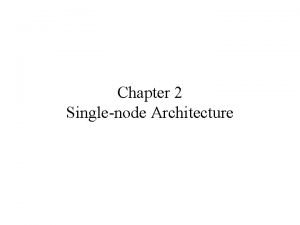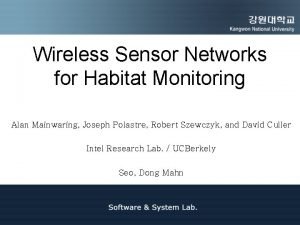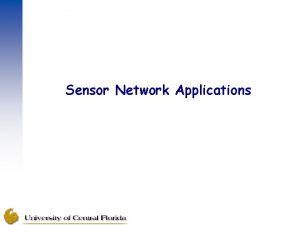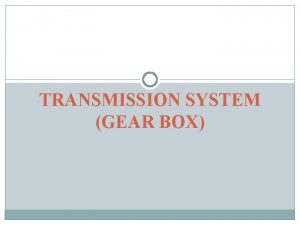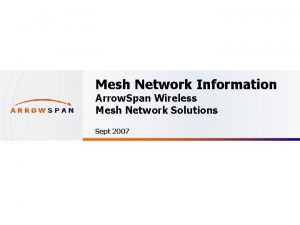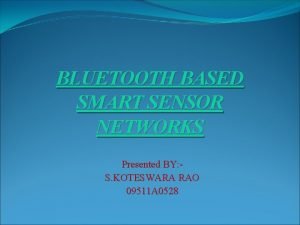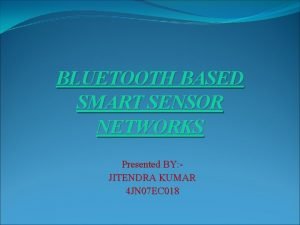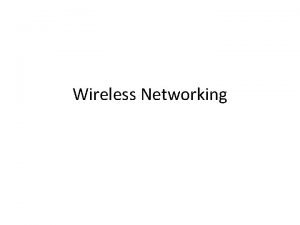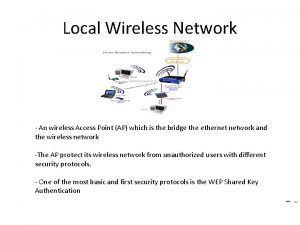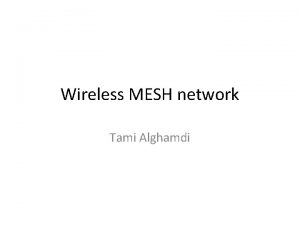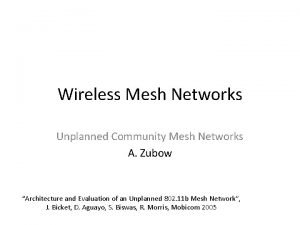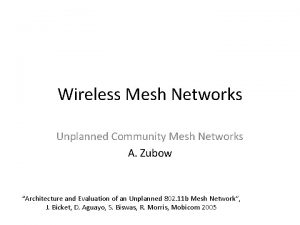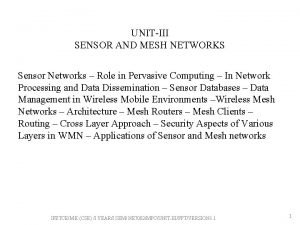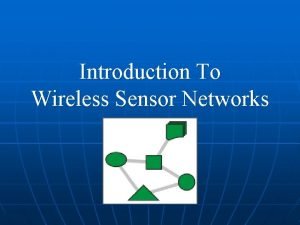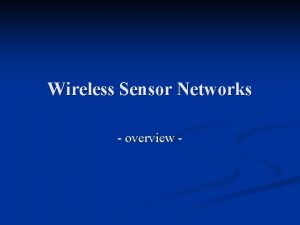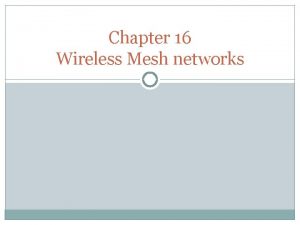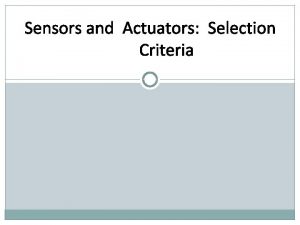Wireless Mesh Networks Wireless Sensor Networks Energy supply













- Slides: 13

Wireless Mesh Networks Wireless Sensor Networks (Energy supply and consumption) A. Zubow

Energy supply of mobile/sensor nodes • Goal: provide as much energy as possible at smallest cost/volume/weight/recharge time/longevity – In WSN, recharging may or may not be an option • Options – Primary batteries – not rechargeable – Secondary batteries – rechargeable, only makes sense in combination with some form of energy harvesting • Requirements include – – – Low self-discharge Long shelf live Capacity under load Efficient recharging at low current Good relaxation properties (seeming self-recharging) Voltage stability (to avoid DC-DC conversion) 2

Battery examples • Energy per volume (Joule per cubic centimeter): Primary batteries Chemistry Zinc-air Lithium Alkaline Energy (J/cm 3) 3780 2880 1200 Secondary batteries Chemistry Lithium Ni. MHd Ni. Cd Energy (J/cm 3) 1080 860 650 3

Energy scavenging • How to recharge a battery? – A laptop: easy, plug into wall socket in the evening – A sensor node? – Try to scavenge energy from environment • Ambient energy sources – – – Light ! solar cells – between 10 W/cm 2 and 15 m. W/cm 2 Temperature gradients – 80 W/cm 2 @ 1 V from 5 K difference Vibrations – between 0. 1 and 10000 W/cm 3 Pressure variation (piezo-electric) – 330 W/cm 2 from the heel of a shoe Air/liquid flow (MEMS gas turbines) Australian inventors are working on micro-electromechanical systems technology that could provide a miniature power source to replace batteries in portable electronic devices. These microelectromechanical systems (MEMS) use fuels such as hydrogen or butane to spin a tiny turbine at very high speeds of up to 2 million RPM. The turbine is made using techniques from the microchip industry and is usually constructed of Silicon. The rotation of the turbine is then used to power a generator that supplies electricity. 4

Energy scavenging – overview 5

Energy consumption • A “back of the envelope” estimation • Number of instructions – Energy per instruction: 1 n. J – Small battery (“smart dust”): 1 J = 1 Ws – Corresponds: 109 instructions! • Lifetime – Or: Require a single day operational lifetime = 24*60*60 =86400 s – 1 Ws / 86400 s ≈ 11. 5 W as max. sustained power consumption! • Not feasible! 6

Multiple power consumption modes • Way out: Do not run sensor node at full operation all the time – If nothing to do, switch to power safe mode – Question: When to throttle down? How to wake up again? • Typical modes – Controller: Active, idle, sleep – Radio mode: Turn on/off transmitter/receiver, both • Multiple modes possible, “deeper” sleep modes – Strongly depends on hardware – TI MSP 430, e. g. : four different sleep modes – Atmel ATMega: six different modes 7

Some energy consumption figures • Microcontroller – TI MSP 430 (@ 1 MHz, 3 V): • Fully operation 1. 2 m. W • Deepest sleep mode 0. 3 W – only woken up by external interrupts (not even timer is running any more) – Atmel ATMega • Operational mode: 15 m. W active, 6 m. W idle • Sleep mode: 75 W 8

Switching between modes • Simplest idea: Greedily switch to lower mode whenever possible • Problem: Time and power consumption required to reach higher modes not negligible – Introduces overhead – Switching only pays off if Esaved > Eoverhead • Example: Event-triggered wake up from sleep mode • Scheduling problem with uncertainty (exercise) Eoverhead Esaved Pactive Psleep t 1 tdown tevent tup time 9

Alternative: Dynamic voltage scaling • Switching modes complicated by uncertainty how long a sleep time is available • Alternative: Low supply voltage & clock – Dynamic voltage scaling (DVS) • Rationale: – Power consumption P depends on • Clock frequency • Square of supply voltage • P / f V 2 – Lower clock allows lower supply voltage – Easy to switch to higher clock – But: execution takes longer 10

Memory power consumption • Crucial part: FLASH memory – Power for RAM almost negligible • FLASH writing/erasing is expensive – Example: FLASH on Mica motes – Reading: ≈ 1. 1 n. Ah per byte – Writing: ≈ 83. 3 n. Ah per byte 11

Comparison: GSM base station power consumption • Overview • Details • (just to put things into perspective) 15

Computation vs. communication energy cost • Tradeoff? – Directly comparing computation/communication energy cost not possible – But: put them into perspective! – Energy ratio of “sending one bit” vs. “computing one instruction”: Anything between 220 and 2900 in the literature – To communicate (send & receive) one kilobyte = computing three million instructions! • Hence: try to compute instead of communicate whenever possible • Key technique in WSN – in-network processing! – Exploit compression schemes, intelligent coding schemes, … 16
 Single node architecture in wireless sensor networks
Single node architecture in wireless sensor networks Habitat monitoring sensor
Habitat monitoring sensor Wireless sensor networks for habitat monitoring
Wireless sensor networks for habitat monitoring Constant mesh gear box
Constant mesh gear box Arrow mesh wifi
Arrow mesh wifi Wireless sensor network protocols
Wireless sensor network protocols Wireless sensor network ppt
Wireless sensor network ppt Forest geove
Forest geove Sensor wireless inc
Sensor wireless inc Bluetooth based smart sensors networks
Bluetooth based smart sensors networks Bluetooth based smart sensor networks
Bluetooth based smart sensor networks Telecommunications the internet and wireless technology
Telecommunications the internet and wireless technology Wireless networking definition
Wireless networking definition Local wireless networks
Local wireless networks
